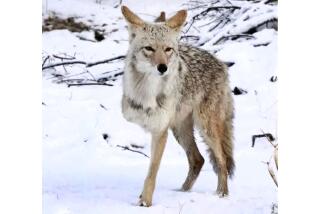Ethiopia hyenas: Not biting the hand that feeds them
- Share via
Reporting from Harar, Ethiopia — Here in this medieval city in eastern Ethiopia, the humans and the hyenas are living in peace.
The truce began two centuries ago (or so the story goes) during a time of great famine.
There was drought in the hills where the wildlife roamed, and hungry hyenas had sneaked into Harar and eaten people.
Distressed, the town’s Muslim saints convened a meeting on a nearby mountaintop. There, they devised a solution: The people would feed the hyenas porridge if the hyenas would stop their attacks.
The plan worked, and a strange, symbiotic relationship was born.
City leaders went on to create holes in the sand-colored stone walls that surround Harar to give the hyenas nightly access to the town’s garbage. And in the 1960s, a farmer started feeding hyenas scraps of meat (goat, donkey, sometimes camel) to keep them away from his livestock.
That farmer was the first hyena man. Today the title belongs to Youseff Mume Saleh.
Lithe and quick, Saleh, who is unsure of when he was born but says he is in his early 50s, has high cheekbones, a pursed mouth and few words. He lives just outside the city walls, near an ancient Muslim shrine built around the trunk of a splendid fig tree. His home sits on an old landfill, the ground sparkling with shards of broken bottles.
Saleh’s nightly feeding ritual has become an attraction for tourists, who hire guides to bring them here. He has grown accustomed to the flash of their cameras and the tips they slip him at the end of the night.
Although the money helps —Saleh has two wives and seven children to provide for —he insists that his custom is not motivated by profit. The hyenas have come to rely on him, he says, and he worries what might happen if he stops.
Across Africa, hyenas are reviled as baby snatchers and garbage scavengers, the villains of village folk tales.
But when they slink toward Saleh’s house at dusk each night —green eyes gleaming, boxy jaws looking so eager to snap — Saleh calls to them.
“Funyamure,” he coos.”Tukwondilli.”
When a stranger later asks why he has given the animals names, Saleh sighs.
“We are family,” he says. “You have to understand.”
***
Not far away, in the town of Maalka Raafu, the hyenas and the humans are at war.
After a band of the animals attacked livestock there this year, an angry rancher spiked a goat carcass with poison, killing the eight hyenas that ate from it.
Four days later, according to news reports, the surviving hyenas retaliated. In a rash of attacks, they killed one girl and injured three other children. The people of the town struck back, slaying several hyenas with axes.
Such violence is unheard of in Harar, where the hyena man’s children laugh when asked whether they are afraid of the animals.
“The hyena is just like a dog,” says 10-year-old Ajebbo.
“No,” says her sister, Ardale, 14. “It is like a cat.”
Last winter, an odd guest showed up at their home.
He was an Australian paleoanthropologist, and he wanted to know whether he could spend time with Saleh while conducting research for his PhD on the city’s unusual social dynamic.
“I heard about this place in East Africa where hyenas walk the streets with impunity,” Marcus Baynes-Rock, 42, says. “I had to see.”
Since then, Baynes-Rock has grown close to the family. On many afternoons, he and Saleh can be found relaxing in the dark cool of the hyena man’s one-room home. They lounge on pillows, talk about hyenas and chew khat, a local plant whose leaves provide a mild stimulant effect. (People in Harar like stimulants: The region’s major export is coffee.)
“Their relationship is just like humans,” Saleh says of the hyenas. “Some fear the other. Some respect the other. Also, they have leaders.”
Baynes-Rock nods. “Some are aggressive and some are passive,” he says. “Some are very bright; some are brave.”
Over the course of eight months, Baynes-Rock has become a kind of hyena man himself.
Each night, once the hyenas have dined with Saleh, Baynes-Rock grabs his notebook, dons his night-vision goggles and follows the pack as it slinks through the town’s narrow alleyways.
“They’re fast,” he says. And they can be devious. A few months ago, a hyena stole an expensive camera lens.
“Can you imagine the insurance claim?” he asks, laughing. “To their credit, the company paid it.”
His obsession with the hyenas —not to mention his white skin, tall frame and fondness for leather motorcycle jackets —has made Baynes-Rock a curiosity in town. As he navigates the streets, striding by coffeehouses, through markets, past churches and mosques, he is frequently followed by groups of barefoot children shouting his name.
This month he married a local woman named Tikist. When they first met at a cafe, she spoke no English, and he had not yet begun learning her native Oromo tongue. He wooed her with photographs of hyenas.
Each year during the Muslim festival of Ashura, the city celebrates the hyena-human peace that the saints arranged many years ago.
On that morning, people leave porridge and butter for the hyenas at the many shrines that dot the town. The hyenas’ reaction to the food is said to predict the new year.
If the hyenas clear their plates, the town should prepare for drought. If they spurn the porridge, danger is afoot. If they eat most of the food but leave some, the villagers can expect a prosperous year.
Baynes-Rock has spent some time with Saleh’s competition, another resident who feeds a different pack of hyenas for an audience of tourists each night. But he dismisses him as “a businessman, not a hyena man.”
Once, in the middle of the feeding, the other man answered a call on his cellphone. Baynes-Rock says he just doesn’t respect the hyenas the way Saleh does.
Respect was a lesson Saleh learned early on. The hyena man bows his head to reveal a slug-like scar behind his right ear.
The attack happened when he was a boy. Saleh saw a hyena on his father’s farm and he hit it with a stick. The hyena tore into him, fleeing only when Saleh’s father came to his aid.
For millenniums, hyenas have been some of man’s fiercest predators. Many of the earliest human fossils, including some discovered in Ethiopia’s Awash river valley, have tooth marks that came from ancestors of hyenas.
“For millions of years we’ve been living alongside these animals and developing a fear of them as well,” Baynes-Rock says. “You can see it in people’s eyes when they see the hyenas at night. It’s a primal fear.”
So why not in Harar?
Abdul-Muheimen Nasser has some answers.
The city historian and overall eccentric (he’s the only man in town who wears a backward baseball cap on his salt-and-pepper afro) says the hyena is “a transmitting station” that communicates news from the spirit world to humans.
He says that at the time Ethiopian Emperor Haile Selassie I died while imprisoned in 1975, a woman who could communicate with the hyenas in town had predicted his death.
“The hyena is the go-between,” Nasser, 69, says. “He is like the CNN or the BBC.”
***
Saleh stabs a piece of camel meat and dangles it in the air. The hyenas skulk toward him. First one, then five, then 15.
He tells them to come. To stop biting. The first hyena lunges for the meat.
A Spanish tourist excitedly snaps photographs. A handful of local boys look on, snickering.
Saleh leaps around the yard flinging scraps into waiting mouths. He uses his body to block the aggressive hyenas so those that have not yet eaten can get their share. He teases the shy ones, forcing them to come close and pull the meat from his mouth.
When he’s out of meat, the spectators shove off and the hyena man shoos the animals into the shadows to finish off their meal.
A call rings out from the nearby mosque, beckoning the faithful to evening prayer. Then all that is heard is the ring of cicadas and the crunch of bones.
More to Read
Sign up for Essential California
The most important California stories and recommendations in your inbox every morning.
You may occasionally receive promotional content from the Los Angeles Times.











